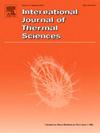An experimental and numerical study of cooling by air/water mist jet impingement at low mist loading fraction
IF 4.9
2区 工程技术
Q1 ENGINEERING, MECHANICAL
International Journal of Thermal Sciences
Pub Date : 2025-02-12
DOI:10.1016/j.ijthermalsci.2025.109788
引用次数: 0
Abstract
The air/water mist jet impingement phenomenon on a flat target with constant heat flux has been studied experimentally and numerically. The effects of various operational variables on the heat transfer characteristics of the mist jet have been analyzed through an experimental study. These variables are the air Reynolds number (Rea = 5305–10297), the mist loading percentage (f = 0 %–1.5 %), and the nozzle-to-plate spacing ratio (H/Do = 20–40). Additionally, the computational study investigates the effects of the nozzle ratio parameter (Di/Do = 0.1–0.3) and droplet diameter (2 μm–100 μm) on mist jet impingement. A comparison between Eulerian-Eulerian and Eulerian-Lagrangian modeling techniques for simulating the air/water mist jet has been provided. The current computational findings based on the Eulerian-Eulerian method accord well with the experimental data, with an accuracy of 15 %; however, numerical predictions using the Eulerian-Lagrangian approach deviate significantly from the experimental results, with errors of up to 65 %. The increase in Rea results in a greater improvement in the stagnation point Nusselt number, up to 85.32 %, compared to 34.99 % with an increase in f. Furthermore, a rise in f causes a greater spread of the mist jet flow in the domain and on the target impingement surface than an increase in Rea. When Di/Do increases from 0.1 to 0.3, the stagnation point Nusselt number increases by approximately 55.67 %. In addition, the spread of the mist jet flow in the domain increases as the Di/Do ratio increases. Experimental correlations have been developed based on studied parameters for calculating the Nusselt number values on the flat target.
求助全文
约1分钟内获得全文
求助全文
来源期刊

International Journal of Thermal Sciences
工程技术-工程:机械
CiteScore
8.10
自引率
11.10%
发文量
531
审稿时长
55 days
期刊介绍:
The International Journal of Thermal Sciences is a journal devoted to the publication of fundamental studies on the physics of transfer processes in general, with an emphasis on thermal aspects and also applied research on various processes, energy systems and the environment. Articles are published in English and French, and are subject to peer review.
The fundamental subjects considered within the scope of the journal are:
* Heat and relevant mass transfer at all scales (nano, micro and macro) and in all types of material (heterogeneous, composites, biological,...) and fluid flow
* Forced, natural or mixed convection in reactive or non-reactive media
* Single or multi–phase fluid flow with or without phase change
* Near–and far–field radiative heat transfer
* Combined modes of heat transfer in complex systems (for example, plasmas, biological, geological,...)
* Multiscale modelling
The applied research topics include:
* Heat exchangers, heat pipes, cooling processes
* Transport phenomena taking place in industrial processes (chemical, food and agricultural, metallurgical, space and aeronautical, automobile industries)
* Nano–and micro–technology for energy, space, biosystems and devices
* Heat transport analysis in advanced systems
* Impact of energy–related processes on environment, and emerging energy systems
The study of thermophysical properties of materials and fluids, thermal measurement techniques, inverse methods, and the developments of experimental methods are within the scope of the International Journal of Thermal Sciences which also covers the modelling, and numerical methods applied to thermal transfer.
 求助内容:
求助内容: 应助结果提醒方式:
应助结果提醒方式:


